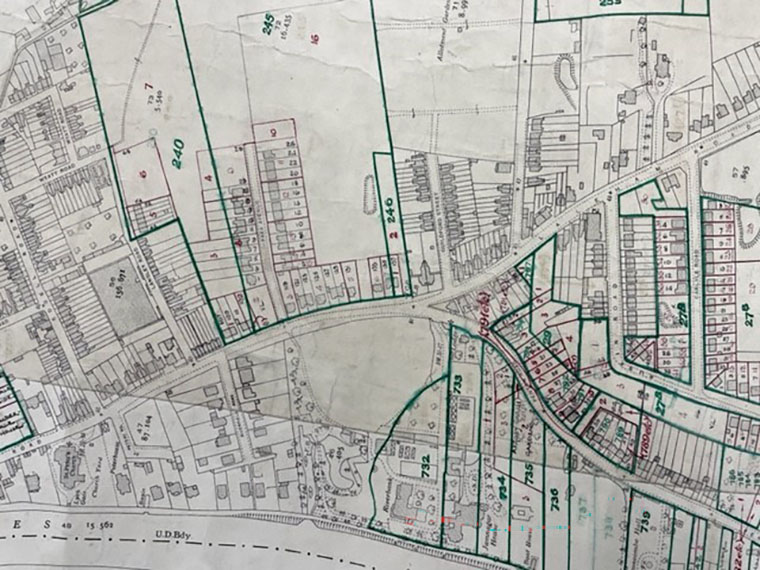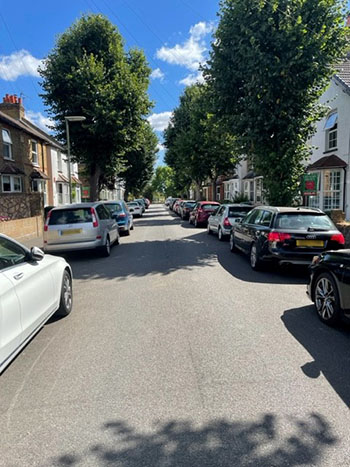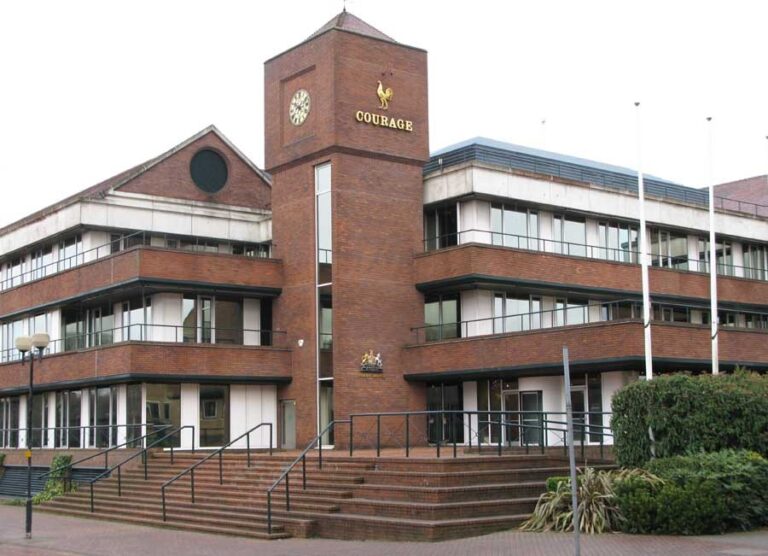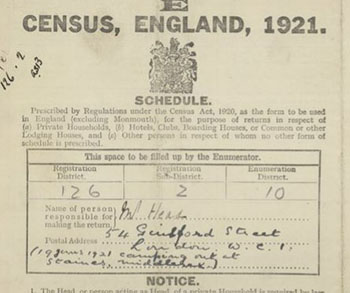This blog post is part of 20sStreets, in which we explore local history stories in the 1921 Census, connecting people of the 2020s with people of the 1920s. Discover your own local history and enter our 20sStreets competition.
Earlier this year, I wrote a blog on the Staines Air Crash, commemorating its 50th anniversary. I’m returning to Staines to look into the local history of the area.
I moved to the market town of Staines nearly 25 years ago and have occupied a semi-detached property in a small cul-de-sac called Guildford Street ever since. The street, situated east off Laleham Road, is not far from St Peter’s parish church, and comprises about 35 residential properties. Most are late-Victorian and are semi-detached with small rear gardens. There is little off-street parking and at the end of the street there are allotments, probably opened after the First World War, and managed by the local council, Spelthorne.
Most of the properties were built between the late 1880s and early 1900s. The street can be researched on all of the decennial censuses from 1891 through to 1921, as well as on the 1939 Register. The properties are numbered up to 39 but curiously there is no number 1, 3, 19 or 38, and for none of the records identified above could I find anybody living at numbers 5, 7, 17 and 36 though on inspection these properties are detached and more modern.
When the street was built, Staines was rapidly expanding and had three railway stations connecting the town with London Waterloo, Reading, Windsor, Weybridge and West Drayton. Properties at the top and bottom of the street were built in the 1880s and 1890s, and a number of properties were added in the middle of the street in the first decade of the 20th century.
In the 1921 Census, there were a total of 35 households. Most properties housed just the one family but some properties, such as numbers 2, 4, 8 and 11, had multiple households.

Over the years, many of the houses have had extensions added at the back or to the side, but in 1921, most were classic two-up, two-down properties with an outside toilet.

According to the 1921 Census, a total of 131 people were living in Guildford Street on the night of Sunday 19 June; an additional two names are recorded but their details have been crossed through, as presumably they weren’t in residence on the actual night of the census. All 131 are recorded as being British and were all born in England, with the exception of Henry and Ronald Breakwell, boarders at number 11, who were born in County Cork in Ireland; 10-year old Canadian-born Ernest Harper, who was residing at number 21 with his uncle James Puzey; Russian-born Ksena Pails at number 8; and German-born Dora Alexander, resident at number 26.
Thirty-eight per cent of the residents were born in the county of Middlesex, including 24-year-old soldier George Leonard Buswell, resident at number 18. George had served with the King’s Royal Rifle Brigade during the First World War and was listed as being born in the village of Heathrow, which would be demolished in 1944 to make way for Heathrow Airport.
Nearly half of the residents were in employment. The biggest employer was the Staines Linoleum Factory which employed 12 labourers from the street. Frederick Walton, the inventor of linoleum, opened the factory in 1864. By 1930 it covered 45 acres. The factory produced the first lino in the world and was the largest employer in the area for many years.

Edward Boulter and Claude Beedell, heads of household at numbers 10 and 22 respectively, were employed as draymen at Ashby’s brewery on Church Street. At the turn of the 20th century, Ashby’s owned more than 200 public houses within 30 miles of Staines. It was later taken over by Courage and the site was redeveloped into flats in the 2000s.

Three residents worked at Staines Candle factory at the corner of the High Street and Kingston Road. Three years later the factory caught fire and it took three hours and 400 gallons of water to put it out. Melted wax blocked the drains and firefighters and policemen had to wade up to their knees in molten wax.
There were also two policemen in residence, one railwayman, one teacher, and two civil servants. Other occupations included a waterman at a nearby boat yard in Laleham, a hammer man, a print compositor, a pavior (paver), a motor mechanic, a dress-maker, a draper’s assistant, a milliner, a jeweller’s assistant, a shorthand typist and a gardener. Most of the women in residence listed their occupation as ‘Home Duties’ and 20 residents were recorded as school children.
The street’s oldest resident, 81-year-old Emma Chapman at number 4, is listed as an Old Age Pensioner – a relatively new ‘occupation’. The 1908 Old Age Pensions Act introduced a pension of between 10p and 25p per week to people aged 70 or over. This came into effect on 1 January 1909, known as Pensions Day. Helping to administer Emma’s pension were Alice Webb and Violet May Capon living at 14 and 31 respectively. Both worked as clerks at the newly formed Ministry of Pensions.
Most of those in the street worked locally in the centre of Staines, only a 10-minute walk away. But others would probably use the train or bus to get to their workplaces in Weybridge, Ashford, Slough and Laleham. Jennie Vary Walker’s workplace was Meccano Limited in Binn’s Road, Liverpool, but she was only visiting the Payne family, resident at number 2. As most factories closed for a period in June for workers’ holidays, it can be assumed that she was on holiday.
The impact of the First World War was felt in Guildford Street as it was all over the country. Thomas Howes, at 15 Guildford Street, was employed as a clerk at the Comrades of The Great War Club. The club had only formed four years earlier as an association to represent the rights of ex-service men and women who had served or had been discharged from service during the First World War. Comrades of The Great War was one of the original four ex-service associations that amalgamated on Sunday 15 May 1921 to form the British Legion.
Amelia Brian, at number 8, was recorded as a widow with two children, aged 17 and three. Her husband, Private Charles Brian of the 54th Company of the Machine Gun Corps, died on 16 November 1918 at the age of 28 and is buried in Lebanon.
Similarly, at number 34, 36-year old Private William Daniel Carey from the 36th Battalion of the Royal Fusiliers was killed on 28 April 1917. By 1921 his widow, Annie Elizabeth, still in residence on the street, had re-married a Sidney Jonathan Sanders and they had a six-month old daughter, Betty Marguerite, who was the street’s youngest resident. Sidney was a fitter’s labourer at the Staines Linoleum Factory.
The Commonwealth War Graves Commission also records the death of Lance Bombardier Herbert Frederick Roake of the Royal Field Artillery. He died on 1 September 1918 at the age of 30. His attestation records, three years earlier, records him as living at 15 Guildford Street with his wife Ethel and three young children, Donald, George and Sylvia. By 1921, Ethel and Sylvia were resident at nearby 87 Kingston Road, Staines. Ethel’s occupation is recorded as a housekeeper. The sons can be found living at the Good Templars Orphanage in Sunbury-on-Thames, four miles away.

There is one anomaly for the census of Guildford Street in 1921 as there is a return for 54 Guildford Street, which has never existed. On closer inspection this was made by 40-year old, Anthony Owen, an insurance broker working at 33-36 King William Street, London EC4. He actually lived at 54 Guilford Street in Bloomsbury. He was resident somewhere in Staines as his return simply states ‘Camping out at Staines, Middlesex’! Well, the 1921 Census was taken on one of the longest days of the year …
Comparing census data for the street, I established that 61-year old self-employed painter and paper hanger William Henry Dean was the longest serving resident. He first appears at newly-built number 35 in 1891 and is still listed resident at the same address on the 1939 Register, so we know he was in residence for at least 48 years.
I’m not sure how long I’ll be resident, but a century on from 1921 the street continues to embrace people from all walks of life. In 2122 somebody may write a blog looking at the street on census night on 21 March 2021. One thing for certain is that it won’t be me.
20sStreets is an exploration of local history stories in the 1921 Census, connecting people of the 2020s with people of the 1920s. Find out more.
Appendix
Guildford Street occupants from 1891 through to 1939 (XLS, 40 KB)
Very interesting reading.
A fascinating insight but we need the mystery of the missing houses solved.
Good stuff. I like it. Fancy doing the same for our former home in Hanwell?
That all made very interesting reading. Do you have any information about the pair of Victorian? houses that stood on the corner of Guildford Street and Laleham Road. (now a block of flats).
As regards the missing houses I assume you have looked at the Victoria County History.
Wow! What a fascinating account. Imagine wading through candle wax! Thank you so much for sharing.